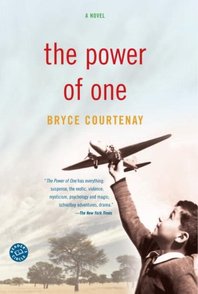
Author: Bryce Courtenay
Publisher: Ballantine Books, 2008, ISBN 978-0-345-41005-4
Lexile Measure: 940L
Classification: Fiction
Summary:
The book’s main character, Peekay, is a young boy (growing into a man) who is relatively unsupervised. He spends most the book either at boarding school, traveling to and from boarding school, or roaming around the outdoors with his friends. Although a few female characters appear in the book, some of whom are strong role models to Peekay, the book takes place in a man’s world.
The book’s main character, Peekay, is a young boy (growing into a man) who is relatively unsupervised. He spends most the book either at boarding school, traveling to and from boarding school, or roaming around the outdoors with his friends. Although a few female characters appear in the book, some of whom are strong role models to Peekay, the book takes place in a man’s world.
Publisher: Ballantine Books, 2008, ISBN 978-0-345-41005-4
Lexile Measure: 940L
Classification: Fiction
Summary:
The book’s main character, Peekay, is a young boy (growing into a man) who is relatively unsupervised. He spends most the book either at boarding school, traveling to and from boarding school, or roaming around the outdoors with his friends. Although a few female characters appear in the book, some of whom are strong role models to Peekay, the book takes place in a man’s world.
The book’s main character, Peekay, is a young boy (growing into a man) who is relatively unsupervised. He spends most the book either at boarding school, traveling to and from boarding school, or roaming around the outdoors with his friends. Although a few female characters appear in the book, some of whom are strong role models to Peekay, the book takes place in a man’s world.
|
|
Language:
Peekay, his friends, and the adult males curse frequently. Profanity includes:
Drug and Alcohol Use: There are references to drinking beer, and smoking.
Violence and Crime:
Sexual Content:
Other Helpful Reviews:
|